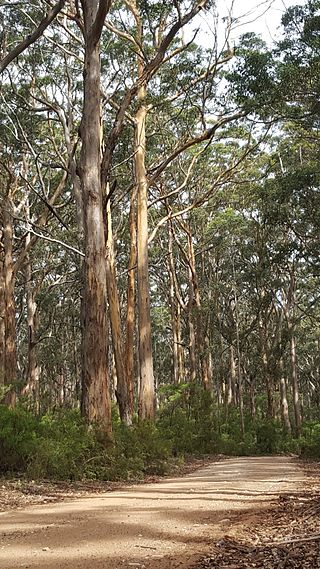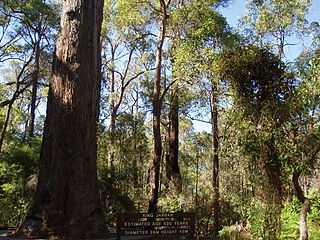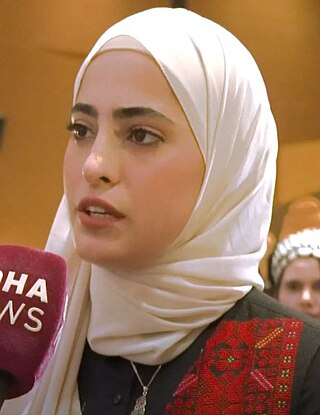
Eucalyptus marginata, commonly known as jarrah, djarraly in Noongar language and historically as Swan River mahogany, is a plant in the myrtle family, Myrtaceae and is endemic to the south-west of Western Australia. It is a tree with rough, fibrous bark, leaves with a distinct midvein, white flowers and relatively large, more or less spherical fruit. Its hard, dense timber is insect resistant although the tree is susceptible to dieback. The timber has been utilised for cabinet-making, flooring and railway sleepers.

Eucalyptus diversicolor, commonly known as karri, is a species of flowering plant in the family Myrtaceae and is endemic to the south-west of Western Australia. It is a tall tree with smooth light grey to cream-coloured, often mottled bark, lance-shaped adult leaves and barrel-shaped fruit. Found in higher rainfall areas, karri is commercially important for its timber.
Saʽid, also spelled Saʽeid, Said, Saïd, Sid, Saeed, Saed, Saied, Sayeed or Sayid, is a male Arabic given name which means "blessed, good luck, joy" or "happy, patient". The name stems from the Arabic verb sa‘ada.

The Old Jarrah tree is an exceptionally large and old Eucalyptus marginata (Jarrah) tree near inside the carpark the entrance at the corner Third Road and Church Avenue in Armadale, Western Australia. It is estimated to be between 400 and 800 years old. Trees of such a great size and age are rare in and around the Perth metropolitan area, because of extensive logging of the area in the 19th century. The tree is in fairly poor condition: about three quarters of its canopy is dead or gone, and it is less than half its normal height due to lopping. It was ringbarked by vandals in 1997, and it has responded by producing numerous epicormic shoots on its north side. Despite these issues, the tree is considered to be in a stable condition.

Eucalyptus patens, commonly known as yarri or blackbutt, is a species of flowering plant in the family Myrtaceae and is endemic to the south-west of Western Australia. It has rough bark on the trunk and branches, lance-shaped leaves, creamy-white flowers and spherical to oval fruit.

Warren, also known as Karri Forest Region and the Jarrah-Karri forest and shrublands ecoregion, is a biogeographic region in southern Western Australia. Located in the southwest corner of Western Australia between Cape Naturaliste and Albany, it is bordered to the north and east by the Jarrah Forest region. Its defining characteristic is an extensive tall forest of Eucalyptus diversicolor (karri). This occurs on dissected, hilly ground, with a moderately wet climate. Karri is a valuable timber and much of the karri forest has been logged over, but less than a third has been cleared for agriculture. Recognised as a region under the Interim Biogeographic Regionalisation for Australia (IBRA), and as a terrestrial ecoregion by the World Wide Fund for Nature, it was first defined by Ludwig Diels in 1906.

Jarrah Forest, also known as the Southwest Australia woodlands, is an interim Australian bioregion and ecoregion located in the south west of Western Australia. The name of the bioregion refers to the region's dominant plant community, jarrah forest – a tall, open forest in which the dominant overstory tree is jarrah.
The western false pipistrelle, species Falsistrellus mackenziei, is a vespertilionid bat that occurs in Southwest Australia. The population is declining due to loss of its habitat, old growth in tall eucalypt forest which has largely been clear felled for tree plantations, wheat cultivation and urbanisation. Although it is one of the largest Australian bats of the family, the species was not recorded or described until the early 1960s. A darkly colored bat with reddish brown fur and prominent ears, they fly rapidly around the upper canopy of trees in pursuit of flying insects.
Jarrah forest is tall open forest in which the dominant overstory tree is Eucalyptus marginata (jarrah). The ecosystem occurs only in the Southwest Botanical Province of Western Australia. It is most common in the biogeographic region named in consequence Jarrah Forest.

Sheikh Jarrah is a predominantly Palestinian neighborhood in East Jerusalem, two kilometres north of the Old City, on the road to Mount Scopus. It received its name from the 13th-century tomb of Hussam al-Din al-Jarrahi, a physician of Saladin, located within its vicinity. The modern neighborhood was founded in 1865 and gradually became a residential center of Jerusalem's Muslim elite, particularly the al-Husayni family. After the 1948 Arab–Israeli War, it became under Jordanian-held East Jerusalem, bordering the no-man's land area with Israeli-held West Jerusalem until Israel occupied the neighborhood in the 1967 Six-Day War. Most of its present Palestinian population is said to come from refugees expelled from Jerusalem's Talbiya neighbourhood in 1948.
Ziyad is an Arabic given name and surname.
Palestinian Australians are Australian citizens of Palestinian origin or Palestinian immigrants who live in Australia. There are an estimated 7,000 Palestinians in Australia.
Jarrah is an Arabic name. The name Jarrah means 'surgeon' in Arabic. The root of the word is derived from the Arabic word "جرح" (jarh), meaning "injury." It is a common surname in the Levant, especially in Palestine and Lebanon. It may refer to:

Nahalat Shimon was a Jewish religious neighborhood of about 40 Jewish families in East Jerusalem in the area currently known as Sheikh Jarrah. It was founded in 1891 by Sephardic and Ashkenazi Jewish Kollels, to house poor Yemenite and Sephardi Jews. The cornerstone of the neighborhood was laid in 1890, near the Tomb of Simeon the Just.
Perthida glyphopa, the Western Australian jarrah leafminer, is a moth of the family Incurvariidae. It was described by Ian Francis Bell Common in 1969 and is known from southwestern Australia.
Hussam al-Din al-Jarrahi was an emir and the personal physician of Saladin, who founded the Ayyubid dynasty and rose to become a prominent Muslim leader during the Crusades. Due to his extensive work in medicine, Hussam received the title of jarrah (جراح), meaning "surgeon" in the Arabic language.
Mohammed el-Kurd is a Palestinian writer and poet, who has gained prominence for his description of Palestinians' lives under occupation in East Jerusalem, the rest of the West Bank; el-Kurd has referred to evictions as a form of ethnic cleansing, and has also accused Israel of imposing apartheid-style laws and regulations onto Palestinians in the occupied territories. He has also spoken out about the oppression in the Gaza Strip, notably the Israel–Hamas war.

The Sheikh Jarrah controversy, which has been described as a "property/real estate dispute" by the Israeli government and its supporters, and as an "expulsion", "displacement" or "ethnic cleansing" event and a matter of international law by Palestinians and their supporters, is a long-running legal and political dispute between Palestinians and Israelis over the ownership of certain properties and housing units in Sheikh Jarrah, East Jerusalem. The evictions are considered a contributory cause of the 2021 Israel–Palestine crisis.

Palestinian displacement in East Jerusalem is the transfer of Palestinian residents from the city due to Israeli policies aimed at an Israeli-Jewish demographic majority. Many Palestinian families in East Jerusalem have been affected by "forced relocation processes or been involved in lengthy legal procedures to revoke an eviction order." According to OCHA, between a third to a half of East Jerusalem's houses do not have permits, potentially placing over 100,000 Palestinian residents of the city at risk of forced displacement and forcible transfer as a result of demolitions.

Muna el-Kurd is a Palestinian activist based in the neighbourhood of Sheikh Jarrah in East Jerusalem. Alongside her twin brother, Mohammed el-Kurd, she drew international attention for her involvement in the Sheikh Jarrah controversy, which served as a key trigger for the 2021 Israel–Palestine crisis. She has regularly protested Israel's eviction of Palestinians in East Jerusalem, and gained prominence for her activism on a variety of social media channels.









